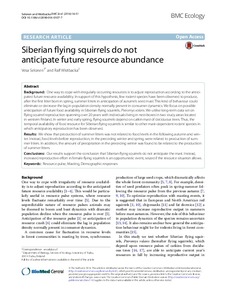Siberian flying squirrels do not anticipate future resource abundance
Selonen V; Wistbacka R
Siberian flying squirrels do not anticipate future resource abundance
Selonen V
Wistbacka R
BIOMED CENTRAL LTD
Julkaisun pysyvä osoite on:
https://urn.fi/URN:NBN:fi-fe2021042715778
https://urn.fi/URN:NBN:fi-fe2021042715778
Tiivistelmä
Background: One way to cope with irregularly occurring resources is to adjust reproduction according to the anticipated future resource availability. In support of this hypothesis, few rodent species have been observed to produce, after the first litter born in spring, summer litters in anticipation of autumn's seed mast. This kind of behaviour could eliminate or decrease the lag in population density normally present in consumer dynamics. We focus on possible anticipation of future food availability in Siberian flying squirrels, Pteromys volans. We utilise long-term data set on flying squirrel reproduction spanning over 20 years with individuals living in nest-boxes in two study areas located in western Finland. In winter and early spring, flying squirrels depend on catkin mast of deciduous trees. Thus, the temporal availability of food resource for Siberian flying squirrels is similar to other mast-dependent rodent species in which anticipatory reproduction has been observed.Results: We show that production of summer litters was not related to food levels in the following autumn and winter. Instead, food levels before reproduction, in the preceding winter and spring, were related to production of summer litters. In addition, the amount of precipitation in the preceding winter was found to be related to the production of summer litters.Conclusions: Our results support the conclusion that Siberian flying squirrels do not anticipate the mast. Instead, increased reproductive effort in female flying squirrels is an opportunistic event, seized if the resource situation allows.
Kokoelmat
- Rinnakkaistallenteet [19207]
